The Ultimate Aquarium Filter Reviews and Buying Guide
Keeping ornamental fish is a satisfying hobby. More and more people are using aquariums as décor in their homes and to attract customers to their businesses. Aquarium popularity even filters down to rooms where an aquarium is not normally in.
Micro-habitat or nano-aquariums are turning up all over the place. Kitchens, bedrooms, home offices, basements and a variety of other rooms have all become popular places for a mini-aquarium. Our most popular requests from kitchen planning specialty firms like kitchendesigncentersc.com or from general interior decorators or space planners.
But, aquariums are more than just beauty. To keep a healthy aquarium, you need several accessories. None is more important than the filter.
Your fish will perspire and poop inside the water. It’s the job of the filter to remove these contaminants out of the water to make sure the water is habitable to the fish, and they don’t die.
Seeing how vital filtration is to your fish, you must take time to find the best one for your set up. Unfortunately, the best aquarium filter differs depending on the size of the tank, your needs and the kind of setup you’re running.
This guide will help you understand aquarium filters better, provide you with comprehensive reviews and a guide that will help you make the right choice when choosing an aquarium filter for your tank.
What are the Functions of an Aquarium Filter?
Understanding the functions of an aquarium filter emphasizes its importance to your aquarium sustenance and why you should take time to find a filter that will keep up with the demands of your tank.
Biological functions
Fish produce ammonia as they breathe through their gills. High levels of ammonia dissolved in the water can harm the fish and cause fin rot and death.
Filtration systems contain biological media filters like bio-balls that contain bacteria that help to break down the ammonia into harmless nitrates.
Mechanical function
Mechanical function removes debris inside the tank. The debris includes fish poop and uneaten foods. At times, dust particles can also find their way inside the tank. To keep the water clear, these particles have to be removed.
Filters rely on mechanical filtration media like a sponge to remove the debris and other visible waste from the tank.
Chemical Function
Water that is safe for human consumption is not always safe for the fish. For instance, chlorinated water can harm your fish. There are other impurities like hard metals that can also harm and even kill the fish.
To avoid this, filters are fitted with chemicals that help to breakdown these harmful substances and make the water safe for the fish.
Best Fish Aquarium Filters Reviews
Based on the functions of an aquarium filter, it’s clear to see why it’s critical to find the right aquarium filter. With many options to consider, this might take time. To make it easier for you, here is a list of some of the best filters that will provide your fish with an excellent environment for them to thrive.
Penn Plax Cascade Canister Aquarium Filter
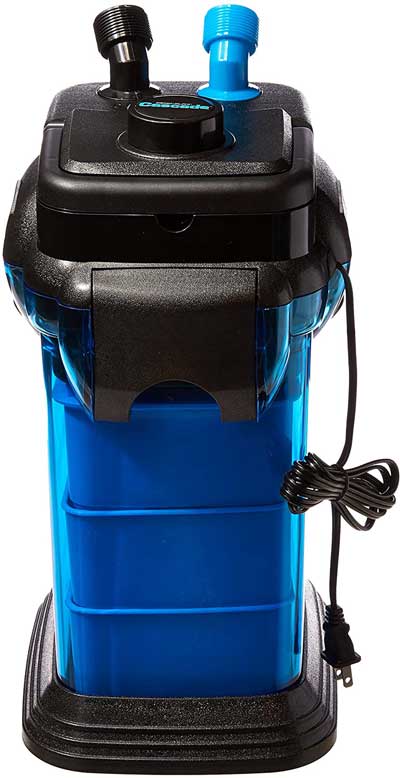
Canister filters are suitable for big tanks that require a high flow rate. The Penn Plax Cascade canister filter works in both freshwater and saltwater tanks. It comes with a variety of filter media to address all your water quality concerns.
The canister has a flow rate of 350gph, which is quite impressive and ensures that waste is removed from the water in a short time.
Being a canister filter, the Penn Plax canister filter is easy to clean. The maintenance of the filter doesn’t interfere with the fish, which reduces contamination. This reduces the need to conduct frequent water changes and allows you to focus more on enjoying the tank.
Pros
- The filter works on tanks as big as 200 gallons
- It is made from quality materials that ensure longevity and long service
- With a high flow rate, keeping the water clean and free from pollutants is easy and fast
- The filter comes with various filter media like bio sponges, bio-floss, and activated carbon to meet all the filtration needs in the tank.
Cons
- The filter produces a bit of noise when functioning. It’s not enough to be a bother but might raise some concerns in the users.
Fluval All-New 07 Series Performance Canister Filter
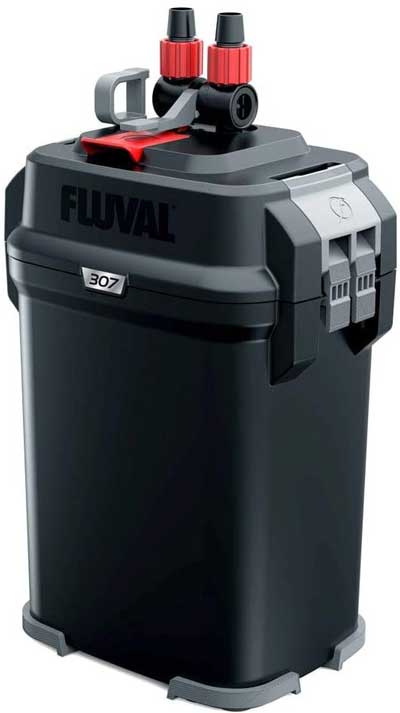
The Fluvial All-New 07 Series boasts of superior filtering capacity and works with a wide range of aquarium sizes, both tropical and marine.
It has a powerful motor that speeds up the filtration process with straightforward functioning and operation.
The filter works silently with minimal vibrations while offering multi-filtration processes that address all aspects that threaten to destabilize water quality in your aquarium.
Pros
- The filter has an automatic start-up option that doesn’t require siphoning to get it started
- It has a clamp that holds it in place for stability and easier operation
- The quiet mode is a great feature that doesn’t set off your antennas every time you power up the filter
- The filter has independent compartments that make it easier to clean the filter and the filter media
Cons
- This is a premium product and costs more than some of the other options in the market
Marineland Magniflow Canister
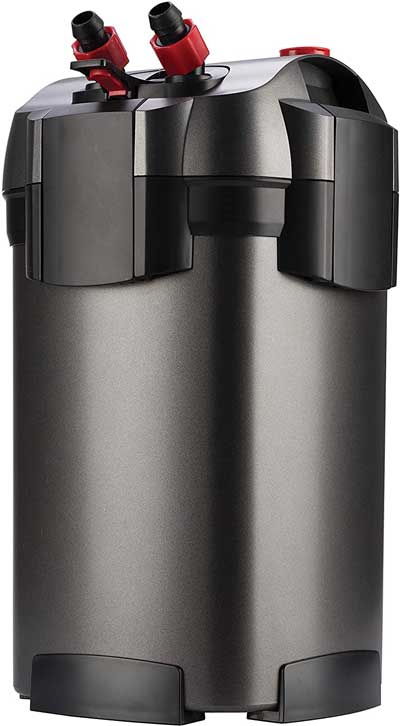
The biggest concern with canister filters is leaking. Without a proper lead, the filter can create a mess. The Marineland Magniflow canister addresses this problem by having a watertight seal that makes leaks a thing of the past.
The filter also has a polishing filter pad that helps to remove finer debris that might pass through the mechanical filtration stage. With the polishing pad, you have clearer and cleaner water for your fish.
Additional filter media include bio-filter balls, and ceramic rings address biological problems like ammonia accumulation giving the filter a multi-pronged approach to keeping your tank clean and safe for your fish.
To remove odor and coloration from the water, the filter has black diamond carbon. This ensures the water remains odorless and crystal clear.
Pros
- The watertight lead ensures no leaks
- The filter is moderately priced
- It operates quietly
- The filter is easy to prime
Cons
- The build of the filter is a bit flimsy.
EHEIM Classic External Canister Fish Tank Filter Media
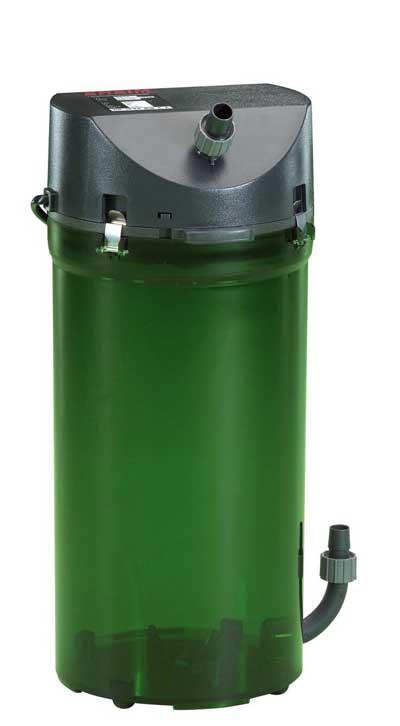
The EHEIM classic external filter is every aquarist’s dream filter. This affordable filter has a permo-elastic silicon sealing ring that prevents leaks while the filter is running.
It also has filter sponges and other loose filter media that address the different functions of a filter. In addition to the filter, you get some excellent accessories like a spray bar for the outlet and inlet and outlet hoses to feed the filter and return water to the tank.
Pros
- The filter is affordable
- It comes with a leak-free lid
- Has plenty of accessories
- You can replace the loose filter media according to your preference and needs
- The filter is easy to clean and maintain
Cons
- The quality of some of the parts could be improved.
Penn Plax Cascade Canister Aquarium Filter Cascade® 1000

Like other Penn Plax Canister filter, the Cascade 1000 is a heavy-duty filter made to keep up with the most demanding filtration needs of any tank. The filter pumps up to 265 gallons per hour and is perfect for aquariums in the 100-gallon range.
The Cascade 1000 delivers powerful and effective performance to provide crystal clear water in both tropical and marine tanks.
The filter has different types of filter media that include coarse sponge for debris, bio balls, and others that help to regulate and maintain water quality.
Pros
- You get free filter media with every Cascade 1000 purchase
- The filter is strong and sturdy giving you long service and value for money
- Different levels of filtration address ammonia, excess foods and other contaminants in your tank.
Cons
- The powerful pump will reflect on your energy bill.
AquaClear Power Filter – 110V
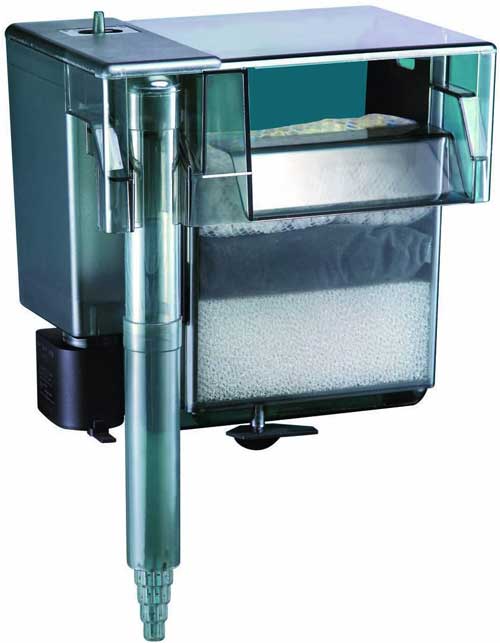
The AquaClear is a hang on Back filter that is perfect for small tanks that don’t have a lot of space inside for internal filters.
Other than the space-saving designs, HOB filters are also known for their effective filtration, and AquaClear has perfected this type of filter, making its product range one of the most prestigious.
The unique design of filter and intake ensures the filter remains unnoticeable and doesn’t take attention away from the tank. It offers multiple filtration stages and helps to cultivate beneficial bacteria that help maintain the quality of the water.
Pros
- Easy installation and operation
- Great design that supports biological filtration
- The motor and impeller last for a long time
Cons
- Unlike canister cleaners, hang on back options are not as easy to clean
Fluval Fx6 Aquarium Canister Filter
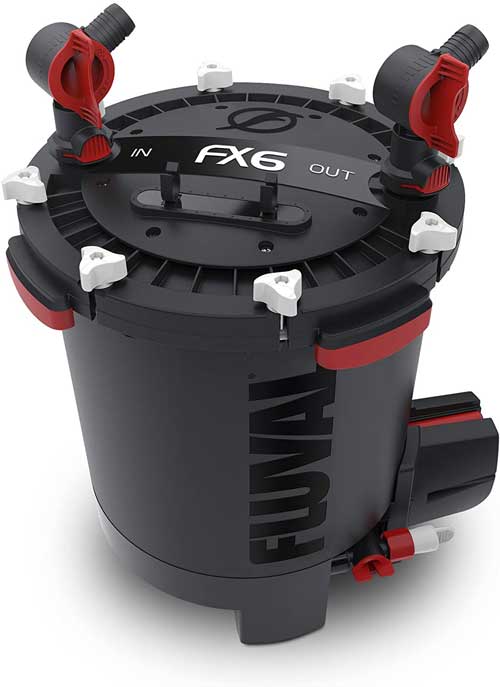
One of the standout features of the Fluval FX6 is the self-priming pump. Once the canister fills with water, the pump starts automatically. This prevents the pump from burning out.
Other impressive features include a purge valve drain at the base of the filter to easily empty the canister for maintenance and a spout that can be adjusted to send multiple streams of filtered water to different parts of the aquarium for uniformity.
Pros
- The intake valve of the canister has a fine screen cover to prevent the entry of debris
- The canister operates quietly and efficiently
- The multi-directional nozzle helps to keep different parts of the aquarium balanced
- The filter has clog-proof technology to keep the system functioning at all times.
Cons
- It could help if the system had different filter media as opposed to the giant sponges inside the canister.
Ehm Fltr Classic 350
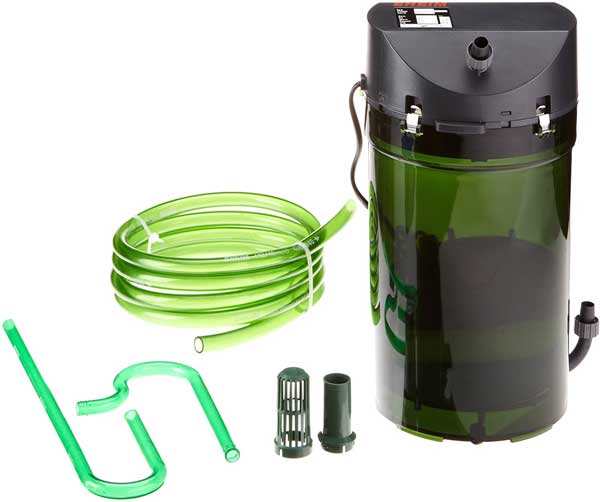
This is a simple canister filter that is both efficient and affordable. It’s a great choice because it comes with a variety of accessories as well as a reliable pump unit that requires minimal maintenance.
The Ehm Fltr 350 puts out impressive performance for its size with high efficiency. It has a one-chamber design that allows you to use different filter media with ease and remove the same for cleaning. You can also swap old media for new ones with relative ease.
Pros
- The pump unit requires minimal service and maintenance
- A single chamber design for stacking up filter media and it’s easy to set up and clean
- Affordable filter with great efficiency
Cons
- It might lose some pumping function intermittently but not for long.
SunSun HW304B 525GPH Pro Canister Filter Kit
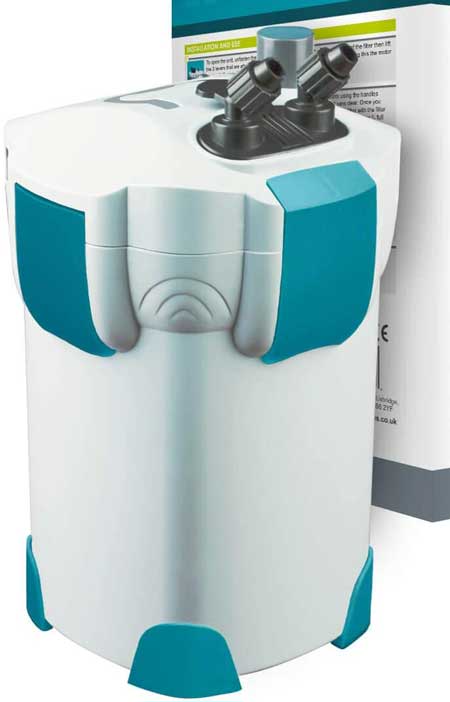
For aquarists looking for a canister filter that can keep up with the demands of a large aquarium and is affordable, the SunSun HW304B ticks on all the right boxes.
This filter can work with aquariums that hold as much as 150 gallons and its 5252gph capacity will ensure water quality is at its best at all times.
The filter has a 3-stage filtration process for different filter media. The stages comprise of mechanical, chemical and biological filter functions to ensure all types of pollutants are removed from the water.
The filter also comes with a 9W UV sterilizer, which improves water clarity and removes algae and harmful bacterial from the water.
With all these features, the filter still maintains low noise during operation and ensures the best performance.
Pros
- Easy to setup
- It has a UV Sterilizer
- Quiet operation
- Pumps an impressive 525gph
Cons
- You might want to replace the filter media with better quality alternatives.
200 Gallon Filter Aquarium Tank Fish Canister
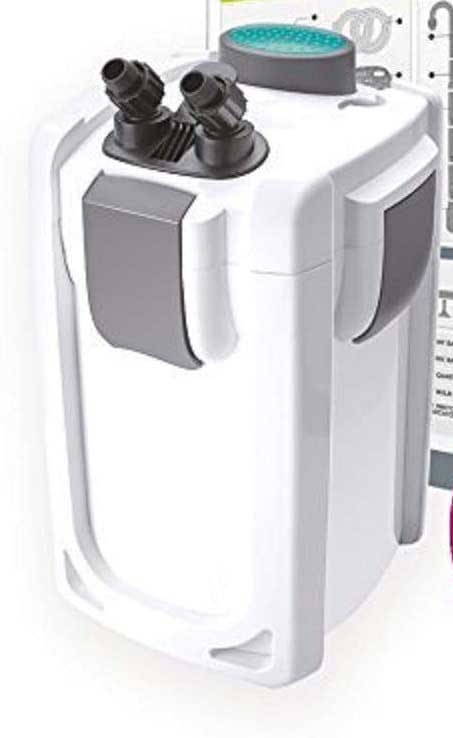
This filter is very similar to the SunSun but has improved features like the 5-stage filtration that caters to all your aquarium’s needs.
The filter is capable of removing more dirt and impurities from the water in one go. The five stages include mechanical, chemical and biological functions as well as a UV sterilization stage.
Like the SunSun, this model is easy to set up and maintain and has a high flow rate of 525 gallons per hour once it’s up and running.
The model comes with everything you need, including the filter media and accessories, so you don’t have to worry about additional expenses.
Pros
- Offers five different filtration stages
- Impressive filtration capacity
- Eliminates bacteria and germs using the UV light
- It has a high flow rate to ensure the effective and quick removal of contaminants from the water.
Cons
- The positioning of the UV light can harm the helpful bacteria as well.
How to Choose the Right Aquarium Filter for Your Tank
Unless you know the type of aquarium filter you want, reviews might not be that helpful. It’s better to start by carefully analyzing the different factors before you settle on the right aquarium filter.
Keep in mind that while this process might take some time, it will save you tons of trouble down the line.
Types of Aquarium Filters
There are different types of aquariums in the market. Each of them has various upsides and downsides, depending on the setting within which it is used.
Air-driven internal fish tank filters
These are small and economic filters that are often used in nano tanks that only have a few fish. Even though they are small, these types of filters are work-horses and well-constructed, which allows them to last for a long time.
Air-driven internal filters only cater to mechanical and biological filtration. They are not equipped to handle chemical filtrations.
Undergravel filters
These types of filters also cater to mechanical and biological filtration. As the name suggests, these filters tuck under the gravel layer, which allows them to be discrete and not mess up with the layout of your aquarium.
lWith under gravel filters, mechanical filtration takes place when the water passes through the gravels while the bacteria trapped in between the gravel take care of the biological aspects.
Compared to other filters, under gravel filters are more affordable but not as effective in removing debris and pollutants from the water.
Power filters
This one of the most common types of filters. It’s widely used in a variety of setups because of how easy they are to use and how long they last.
Power filters provide balanced performance and cater to all functions of filtration that include mechanical, biological and chemical filtration. The filter is fitted with different filter cartridges that cater to each type of filtration.
Internal filters
Internal filters go inside the tank. They are submersible filters fitted with a pump that sucks in the water and forces it through different types of media inside the filter through suction force.
These types of filters are extremely practical and are often fitted with suction cups that allow them to stick to the sides of the tank.
Depending on the power of the filter, internal filters can work with most small to medium-sized tanks with plenty of success. However, it’s important to point out that they cater to biological and mechanical filtration only.
Hang on Back Filters
You take a lot of time to make sure the aquascape of your aquarium is just perfect. The last thing you need is a chunky filter sitting on the side. For aquarists that can’t stand to have the internal filter ruining the look of the aquarium, the hang on back (HOB) filters are a worthy alternative.
HOBs also work in small aquariums that don’t have much space to fit in an internal filter. The filter hangs on the back of the aquarium. It sucks water and passes it through different filter media before directing it back to the tank.
These unique filters are efficient, simple to use, and long-lasting. They cater to mechanical and biological filtration.
Canister Filters
These are the gold standard filtration. Canister filters have everything your tank needs to provide your pet fish with the best environment and water quality.
These filters work best with large aquariums with many fish that require a filter with a high flow rate to remove toxins and pollutants from the tank in the shortest time possible.
The filter has an inlet host that sucks water from the tank and directs it through the different filter media before pumping out of the outlet hose back into the pump.
Canister filters come in different sizes and with different features. If you choose to get one, it’s imperative you take some time to identify the best one for your tank.
Wet and Dry Filters
Wet and dry filters are known for their excellent biological filtration and enhanced oxygenation. They are an excellent fit for saltwater aquariums that require exceptional biological filtration.
The wet and dry filter get their name from the fact that the filter media is exposed to water and air at the same time. This allows the filtration media to have plenty of bacteria that helps to break down ammonia to nitrates.
What to Consider When Choosing an Aquarium Filter
Now that you know what each type of filter has to offer and the environment its best suited for, you can start assessing the best filter for your tank by considering various factors that might help you determine which filter will work best for you.
Size of tank
The size of the aquarium is a leading factor to consider when buying a filter. Larger tanks will require efficient and effective filters that can go through the water several times each hour. Smaller tanks don’t have significant demands and can work relatively well with small filters.
For large tanks, wet/dry and canister filters are recommended. For some sizes, the internal and power filters might also work.
Fish population
Tanks with more fish require better filters compared to those that have few fish. The more the fish, the more ammonia released into the water. Tanks with more fish also tend to have more poop and debris which requires immediate removal.
Types of livestock
When choosing a filter, it’s important to consider the type of livestock you have in your tank. Tanks that have shrimps generally require filters with low flow rates or those that are fitted with safety guards to keep the shrimp from being sucked into the filter. ‘
Some types of fish and shrimp are also very delicate and sensitive to the slightest change in water quality. Tanks with such species require filters that are incredibly effective to keep the fish and other livestock healthy.
Hardy types of livestock are not as demanding. Nonetheless, these also require decent filtration to keep the water from becoming toxic.
Water quality
As you might have noticed, most filters save for the canister filter don’t have chemical filtration. For areas with good quality water or for homes with a reverse osmosis filtration system, chemical filtration is not necessary.
If the area has poor quality water with metals and chlorine is used in the process of purification, you need a filter with chemical filtration media. Alternatively, you can treat the water before adding it to the aquarium.
Maintenance
Most aquarists, especially novices, tend to overlook the amount of maintenance required to keep the filter functioning properly. Even though the filter works to keep the tank clean, it also needs some maintenance and cleaning to keep it running smoothly.
Some varieties like canister filters are easier to clean and maintain compared to wet-dry and internal filters that require you to get your hands dirty.
Other than the type, the design of the filter can determine if it’s easy to clean and maintain. It’s something you have to consider before paying for the filter.
Cost
Ideally, you should expect to pay more for good quality and efficient filters. This is more so the case if you have delicate and expensive fish.
With regards to cost, aim to get the best value for your money as opposed to going for cheap options that will not last.
Conclusion
Get your aquarium hobby started on the righting footing by investing in the right aquarium filter. This all-in-one guide will help you decipher all the technical jargon and determine the best aquarium filter for you. The guide also includes reviews of some of the best filters in the market, which can help you quickly jump on an acceptable option, especially if you already know and understand what you’re looking for.
